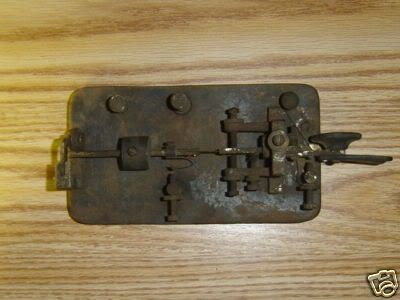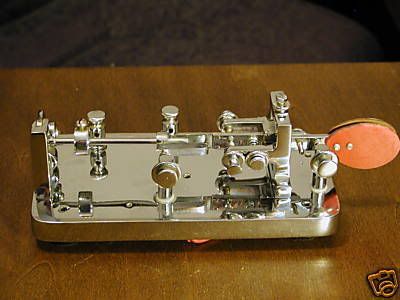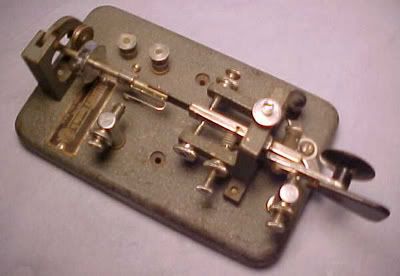I haven't written much lately about my latest eBay finds, mostly because they tend to happen quite by accident — the accident being if I think the proverbial “price is right.”
I've got enough 1950s Vibroplex keys (though I still would go after a Blue Racer should I find a good deal on one), and being a cheapskate, I don't have the money to go after the most collectible keys out there. There have been some really collectible keys passing through eBay, but I'm happy to let the elite (i.e. deep pockets) collectors try to out-snipe one another.
But I do enjoy chasing the unusual keys, and particularly looking for the hidden gems that lie among various and sundry eBay listings.
EARLY VIBOROPLEX ORIGINAL. The key at right may not look like much in the photo, but it is a very early Vibroplex Original. The auction listing had little detail, and there is no label on the key. The photos aren't very revealing (like the one I have here), or they weren't until I opened them in Photoshop and lightened them up a great deal.

It was only then that I could see the tell-tale details that revealed the key was an early Vibroplex, probably not a first-year 1905 key, but no later than 1909 or 1910. After positively ID'ing the key, I decided to keep an eye on it to see how many others saw what I saw.
There were eight bidders total, including me. Six of them entered proxy bids, meaning they entered a maximum bid and let eBay's proxy bidding system take care of any rebids up to their limit. The final 10 seconds of the auction came down to myself and another bidder. I bid last with my snipe and won the auction. Judging from the amount the other bidder entered as his final bid, he was the only other bidder who understood what the key was.
I have the key but have not tried restoration or much anything with it yet. The purist among collectors say that leaving them in as-found condition is the best way to keep them. I don't think I agree with that, since this isn't exactly a super rare key. It won't be a loss to the industrialized world if I cleaned up the key and put it to use. The key has a coating of gunk on it now, and I plan to later carefully try to clean off the gunk.
The seller isn't very happy with me. He took this wonderfully preserved old key and jammed it into a too-small Priority Mail box and packed it like it was a lightweight item. The results? The thumb piece (paddle) on the key was broken off. It's not a clean break either, and the bakelite actually bent before it broke, making the break too nasty to repair with super glue. I gave the guy neutral feedback for it. I didn't bad mouth him, just stated the truth. Hey, it could have been negative feedback!
UNKNOWN PRE-1930 BUG. The key pictured at right was one of the rare eBay finds that you stumble upon when you are checking the auction listings that were just uploaded.

I have seen examples of keys that match or nearly match this key. It's model after the Vibroplex Original, though it certain is not a Vibroplex key. I was fortunate to run across this listing, it was only about 40 minutes old when I saw it and nabbed it via Buy It Now.
This key appears to have been professionally replated in chrome, judging by the quality of the finish. There's no ID tag on it, though there is a spot for one that would run across the base from one side to the other. The plating job is fantastic; the key could pass for brand new. I know nothing of its history, and the auction listing didn't mention it.
Unlike the Vibroplex keys, this one has four feet, the screw holes pass all the way through the body of the base. The pivot frame differs from the Vibroplex in minor ways, but the keying lever has a pinned-hinge style similar to the pre-1921 Vibroplex keys.
It is very similar to the Leach Speedoplex No. 2 I have owned for several years, but with several minor differences. This key uses the very early style Vibroplex wire terminals (my other one uses knurled nuts), and the other Speedoplex I own has three feet. An earlier version? There's no way to tell. The key came assembed and functional, and I can attest that the knurling patterns on the jam nuts and screws is not of Vibroplex origin. Who doesn't appreciate a mystery?

TELEGRAPH APPARATUS CO. CP-500. This key was purchased from Tom French, one of the nation's top key collectors and authors on the subject. This particular key was listed for sale on his web site (and still is, for a cool $195, much more than I paid for it). Tom also sells a variety of other key parts, including replacement parts and hard to find key springs.
According to Tom's notes on his web site, this particular model key was the first offered by the Telegraph Apparatus Co. of Chicago in 1944. TAC was a partnership between Ted McElroy (of Mac Key fame) and some partners in Chicago. TAC concentrated on manufacturing keys and McElroy's company in Boston worked to fulfill war contracts for other telegraphy equipment.
The pivot frame and damper are direct copies of the Vibroplex design. The wheel on the damper has groove for a rubber O-ring, which I assume would make the key less noisy. As Tom notes, this key is rarely seen for sale. The TAC 510 and 810 (the “Hole-In-The-Wall” design) bugs are much more commonly found.
I've been playing with the key and it has a fairly good feel to it. Very similar (of course) to the feel of the later TAC bugs. I haven't really cleaned the key or done much with it beyond try it out, but so far so good. It's on the desk ready to go to work. The key is a grayish-blue color, and even the damper and pivot frame are painted. On spots where the paint is rubbed through, the original brass shows through. It's a very interesting key, and my first CP-500.
OTHER EBAY PURSUITS. While I haven't been doing much looking at rigs while browsing eBay, it seems I've been commissioned to “find” stuff for members of my family. My daughter needed a certain model TI graphing calculator, and a new one runs more than $100. I found one for less than half price on eBay. Geeky kid that she is, she spent all weekend entering programming into the thing so it will play games and compute a variety of forumulas. And yes, today I bought the PC data link for her calculator so she can download “stuff” to it.

In the quest for a new microphone I've found a fairly nice looking clone of my favorite classic microphone, the Shure 55S. I have one on a mic boom in my shack. It's a vintage mic, with adjustable impedance, and works fairly well with my IC-756PROIII. The old mic doesn't have the output that other mics have, so I have to crank the gain up on the thing.
But now a reproduction version of the Shure 55S, the OSP DL-280, looks promising. It's a dynamic microphone with respectable specs. It looks nearly identical to the Shure mic too — in fact, its a much better looking mic than the Heil Heritage, which doesn't resemble the Shure 55 as much as it does the Cardax 950.
Now the real question may be this: If I already have the original (and classic) Shure 55S on my mic boom, why the hell do I want to buy a reproduction of the same mic?? The answer is that I'm not sure the original mic is operating “up to snuff.” Sure it works, but the output is always notably less than other microphones, including any of my Heil headsets.
Perhaps I simply need to finish the Heil cartridge project I started last year — I have a Shure 55S that was case only, and I have a Heil HC-5 cartidge to mount inside it. Certainly would be cheaper to complete the Heil 55S and compare that mic with the original one. Of course, with audio adjustments on my Icoms, I can do a little bit of tailoring on the audio. A new plug-and-play (and newly chromed and shiny) mic just seems like a good option — particularly since its less than half the price of a new Heil mic.
So much equipment, so little time … sigh.
73 all, de KY4Z … dit dit ….
